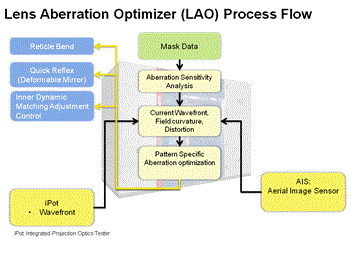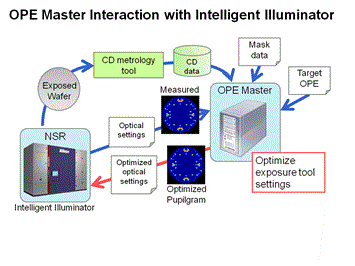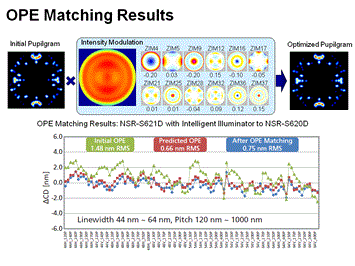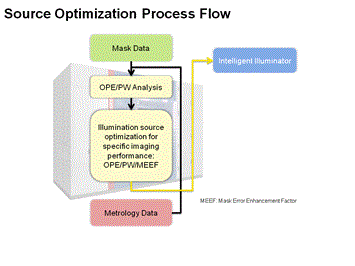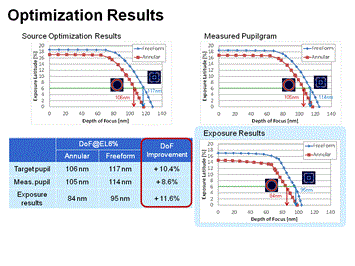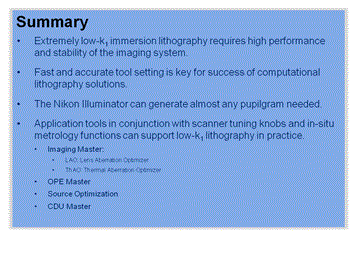Enabling 193 nm Immersion Extension with Computational Lithography Solutions
Extension of ArF or 193 nm immersion lithography is imperative for IC makers to maintain their roadmaps, with computational lithography a critical part of extending their capabilities. Extremely low k1 lithography processes require complex source shapes from source mask optimization (SMO) as well as common OPC behavior from different scanner vendors. Additionally, these low k1 processes require stringent control of dose, focus, thermal aberrations, and CD uniformity (CDU). This necessitates comprehensive computational lithography solutions that can expand process windows and increase imaging robustness. At the SPIE Advanced Lithography conference held earlier this year, Nikon experts provided valuable insight on scanner software solutions to address these challenges, and they are summarized in this article.
Nikon supports computational lithography in several key areas, including freeform illumination and OPE matching (matching optical proximity error for common OPC behavior). The Intelligent Illuminator Unit (IIU) works in conjunction with a variety of related software applications to enable low k1 lithography by generating freeform sources, enabling source modulation for OPE matching, and supporting post-mask source fine tuning. The iPURE unit, which is the optical engine of the Intelligent Illuminator, can generate pupilgrams to match essentially any customer request. Nikon enables source-mask optimization on its scanners by partnering with EDA vendors to enable IIU-aware SMO solutions. Work performed with Synopsys demonstrated that the IIU can produce Proteus SMO-recommended sources almost perfectly with regard to source fidelity and imaging performance, with the measured source matching the SMO result for process window and delta CD (figure 1A).
-
Click image to enlarge.
-
Figure 1A. Work performed with Synopsys demonstrated that the IIU can produce Proteus SMO-recommended sources almost perfectly with regard to source fidelity and imaging performance.
Beyond an Intelligent Illuminator, advanced software solutions are essential to a complete computational lithography program, and Nikon has a suite of software solutions that address specific low k1 challenges to optimize imaging control (figure 2A). The Lens Aberration Optimizer (LAO) tunes the lens specifically for individual masks to extract the most performance. It does this by using aberration sensitivity analysis combined with wavefront, field curvature, and distortion information. Those results are then fed back to the scanner for adjustment using the Reticle Bending, Quick Reflex, and Inner Dynamic Matching Adjustment Control functions (figure 2B).
Figure 2A. Nikon has a suite of software solutions that address specific low k1 challenges to optimize imaging control (left image). Figure 2B. LAO optimizes the lens specifically for individual masks to extract the most performance.
Since today’s exotic pupil fills can generate unusual thermal aberrations in the lens, an efficient method to predict and control those aberrations is also needed to make SMO solutions viable on scanners. The Thermal Aberration Optimizer (ThAO) method performs high-accuracy, off-line thermal aberration prediction. Then, a Zernike sensitivity analysis of the thermal aberration optimization process follows. The scanner’s lens controller parameters are subsequently optimized based on this information. The last phase of this procedure includes fine-tuning the thermal aberration control parameters. As a result, the thermal aberration parameters are automatically optimized and set on the scanner without time-consuming dummy heat testing.
OPE Matching, to ensure the same OPC response from different scanners, is also a key element in computational lithography. To do this, Nikon provides the OPE Master system, which interacts with the Intelligent Illuminator to enable Nikon-to-Nikon or Nikon-to-competitor scanner OPE matching. OPE Master accepts CD data from the scanner of interest and from a reference scanner, and then, using customer pattern information and internal data from the scanner, recommends scanner adjustments to minimize the difference between them (figure 3A). OPE matching studies have shown that CD differences were significantly improved using OPE Master for the S621D with IIU modulations. In the example shown in figure 3B, CD matching errors were reduced from ~1.5 nm to 0.75 nm (RMS).
Figure 3A. Nikon provides the OPE Master system, which interacts with the Intelligent Illuminator to enable Nikon-to-Nikon or Nikon-to-competitor scanner OPE matching (left image). Figure 3B. OPE matching studies have shown that CD differences were significantly improved using OPE Master for the S621D with IIU modulations.
After the mask is made there is still room for optimization to avoid performance limitations due to mask errors or other effects. Nikon Source Global Optimization software recovers performance, using IIU pupilgram freedom, and can optimize for process window, mask error enhancement factor (MEEF), and OPE (figure 4A). A sample Source Global Optimization evaluation was performed using the S621D with the Intelligent Illuminator evaluating two-dimensional test patterns with 12 types of 80 nm x 190 nm rectangular patterns with various pitches. The goal was to improve the process window without changing OPE behavior or requiring a new OPC model. The software modified the illumination pattern, the exposure was performed with the new source, and the software successfully improved the S621D immersion scanner process window without impacting OPE behavior (figure 4B). This was shown by lithographic measurements, not simulation.
Figure 4A. After the mask is made there is still room for optimization to avoid performance limitations due to mask errors or other effects using Source Global Optimization (left image). Figure 4B. Source Global Optimization software successfully improved the S621D immersion scanner process window without impacting OPE behavior.
CDU Master is the remaining imaging control software element. It not only improves CDU performance of the scanner, but also enables the scanner to correct for CDU error contributions in the overall ecosystem, such as processing non-uniformity. A key aspect of this system is the simultaneous compensation of dose and focus offsets, which successfully maximizes the process margin of a target pattern. Marked improvements have been demonstrated using CDU Master. S621D across wafer CDU 3σ results have been improved by more than 50% to 0.6 nm for inter-field and 0.7 nm for intra-field measurements.
-
Click image to enlarge.
-
Figure 5A. Nikon application software used in conjunction with scanner tuning functions enable 193i to support the most demanding next-generation manufacturing requirements.
Extremely low k1 lithography processes require exceptional performance and stability of the imaging system, and fast and accurate tool setting is imperative for the success of computational lithography solutions (figure 5A). The Nikon IIU can generate essentially any pupilgram needed with fine grayscale levels, and comprehensive Nikon application software─used in conjunction with sophisticated scanner tuning functions─enables 193i lithography to support the most demanding next-generation manufacturing requirements.


